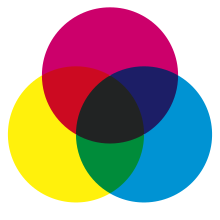Subtractive color mixing

As a subtractive color mixing , subtractive color synthesis or physical color mixing changing a is color stimulus for reflection from the surface of a body by remission or during passage through a medium ( color filter ) by transmission , respectively. If, on the other hand, something is added, color stimulus to color stimulus, one speaks of additive color mixing .
So, starting with white as the basic color, color components are removed by absorption or filtering.
In a narrower sense, subtractive color mixing is the extreme principle in which the diversity of the color space is reproduced by connecting three color filters in series.
Physical process and concept
The subtractive color mixing cannot be explained by simply reversing the additive color mixing. In contrast to additive color mixing, a physiological color mixing, it is a purely physical process, also called physical color mixing, which is independent of color perception . There is a change in the light spectrum or the color stimulus, while its physiologically colored effect ( color valence ) is based on the additive color mixture taking place in the eye and brain.
The changed light spectrum is the result of the spectral reflectance (measure of reflected light) and transmittance (measure of transmitted light). The product of these reflections or transmissions with the original spectral distribution (radiation) is called the changed radiation distribution ( color stimulus function φ (λ) ). The changed color stimulus function is reduced to fewer parts of the light spectrum (subtractive = reducing) than the primary one. Something is taken away from the radiant energy .
Conditionally identical color filters result in different color stimuli when connected in series with a further filter, while conditionally identical colors (radiations) behave in exactly the same way with additive color mixing.
The explanation is based on the three-color theory and the fact that the cones on the retina of the eye have their maximum sensitivity for those wavelengths of light to which we assign the color sensations blue , green and red : If in the arrangement above the color filters are yellow, Illuminated magenta and cyan with neutral white light, complementary colored spectral ranges are filtered out by absorption . With the yellow filter, for example, the blue area is absorbed. The passing spectrum can hardly or hardly stimulate the blue-sensitive cones and is therefore registered as yellow by the eye. The yellow and cyan filters together absorb the blue and red areas. The green area, for which the eye has its own type of cone, can pass. Where the magenta-colored filter is added, the achromatic color black is perceived, because it absorbs the green area that was still allowed through. The unaffected original light passes outside the filter and causes the eye to perceive the highest brightness, i.e. the color impression white.
The colors of the filters, yellow, magenta and cyan in the picture above, are designated as the primary colors of the subtractive color mixture, the colors produced as secondary colors , here blue, green and red.
Applications
Body colors
The colors absorb (swallow) certain light waves and reflect the others. Example: A "red" body irradiated with white light reflects the red part of the irradiating light and absorbs the remaining parts. Since the body surfaces are usually not equally smooth or not equally rough, the color stimulus also changes because the light scattering is different.
Filter colors
Color printing and photos on paper
When printing , the transparent color layers cyan , magenta and yellow ( CMYK process, for example in the case of an inkjet printer ) are placed on top of one another on a white surface. The process that changes the light spectrum takes place both before and after the reflection on the substrate.
In the case of colored paper photos, too , transparent layers of color, which follow the contours of the content of the image, lie on top of one another on a white surface.
Color film
In the case of the color films , transparent layers of color are superimposed on a crystal-clear carrier film . They change the color spectrum of the light shining through. The principle of both negative film and slide film is subtractive color mixing. The "negative" colors are on the negative film, which are the complementary colors of the "correct" image colors created on the paper image in the subsequent process. The "correct" image colors are already "mixed" on the slide film.
See also
literature
- Manfred Richter: Introduction to colorimetry. De Gruyter, 1981, ISBN 3-11-008209-8 , Chapter 11: So-called subtractive color mixing
- Harald Küppers : The basic law of color theory . DuMont Literature and Art Verlag, Cologne 1978. 10th edition 2002.
Individual evidence
- ↑ Manfred Richter: Introduction to colorimetry . De Gruyter, 1981, ISBN 3-11-008209-8 , pp. 51 and 81
- ↑ Manfred Richter: Introduction to colorimetry. De Gruyter, 1981, ISBN 3-11-008209-8 , p. 87
- ↑ Harald Küppers: The basic law of color theory . DuMont, 2004, ISBN 3-83-2-11057-7 , p. 175
- ↑ a b Harald Küppers: The basic law of color theory . DuMont, 2004, ISBN 3-83-2-11057-7 , p. 178
- ↑ a b Manfred Richter: Introduction to colorimetry. De Gruyter, 1981, ISBN 3-11-008209-8 , p. 89
- ↑ Therefore, mathematically speaking, one should strictly speak of multiplicative instead of subtractive mixing
- ↑ Manfred Richter: Introduction to colorimetry. De Gruyter, 1981, ISBN 3-11-008209-8 , p. 88

